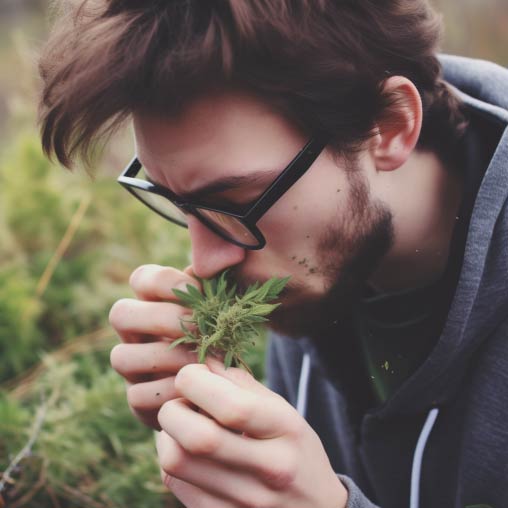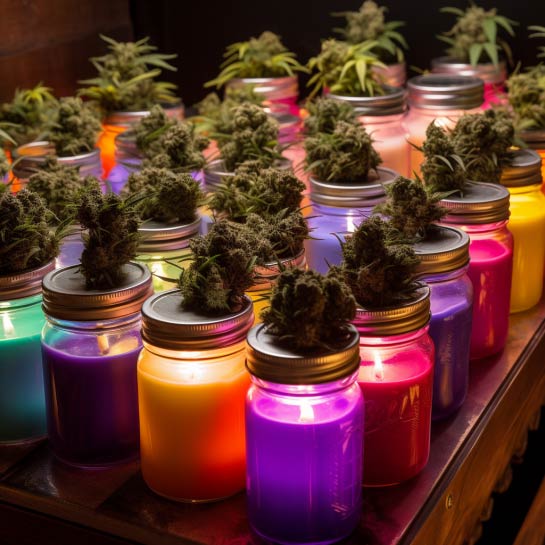Art & Photos Courtesy of Rebekah Jenks
What does weed smell like?
You know it when you smell it, but then again, you can’t just describe one cultivar and have it accurately represent all buds. Some are sweet, some are pungent, there are even unpleasant smelling cultivars with horrific sounding names like “Halitosis.” But what determines the aromas of cannabis buds?
 Most cannabis consumers in medical or adult-use legal states have heard of terpenes by now. They are the fragrant, essential oils found in the same resinous material that contains THC, CBD, and other cannabinoids we value so much. But what about Thiols, Esters, Aldehydes, and other chemicals found in your weed that contribute to the complex smells?
Most cannabis consumers in medical or adult-use legal states have heard of terpenes by now. They are the fragrant, essential oils found in the same resinous material that contains THC, CBD, and other cannabinoids we value so much. But what about Thiols, Esters, Aldehydes, and other chemicals found in your weed that contribute to the complex smells?
Currently, science has identified approximately 550 chemical compounds that may be present in cannabis. Over 100 of those are cannabinoids (many are currently undefined) and more than 200 are terpenes. But what about the other 250 plus chemicals? What are they and how do they contribute to the smell and effects?
Due to prohibition and restrictions on research, the science on the chemical effects of cannabis is still in its infancy and much is yet to be discovered, but some information on what contributes to smell is known to scientists and now more commonly to weed nerds. Some of the scents, like the skunky smell, that are iconic in weed-culture are not a result of terpenes, at least not exclusively. Most of us who have heard of terpenes and have a basic understanding of what they are and how they are capable of affecting us have heard of the Entourage Effect. This is the concept that it is more than just THC that drives the effects of cannabis; it is many of the 550+ chemicals working in concert with each other that causes subtle differences in effects noticed from one cultivar to another. This subtlety is also present in the variety of smells.
Does your weed smell fruity, or gassy, or flowery, or spicy, or like blue cheese, or all these combined? Sometimes, even trained professionals like Ganjiers, the trained sommeliers of cannabis, have a hard time determining where one aroma ends and another begins.
The six major categories of aroma that have been established by leaders in the cannabis industry are Fruit, Floral, Earth, Fuel, Sweet, and Faulty. But terpenes aren’t responsible for all these smells, not by a long shot. Let’s look at what else is contributing to these aromas.
 Thiols
Thiols
Thiols are sulfuric analogs of alcohols, which are slightly modified forms of alcohols. They are primarily responsible for the skunky aroma in cannabis. The particular molecule, 3-methyl-2-butene-1-thiol, or 3-MBT, is the same molecule that makes some beer smell skunky. Thiols can also produce an “eggy” smell, and probably more popular, a garlic aroma that has been recognized in the cultivar Garlic Cookies, or GMO as it is sometimes called. However, in tiny amounts, thiols can produce fruity and sweet smells often found in some wines.
Aldehydes
Aldehydes are a result of an oxidation of some alcohols. Like thiols, aldehydes can be sweet and floral but can also be pungent and offensive depending on their molecular weight. These molecules, found in vanilla, cinnamon, or flower petals, are sweet, spicy, or floral and can be a result of aldehydes, but they can also smell like rotting organic matter.
Esters
Esters are derived from acidic and alcohol compounds and can be responsible for some of the more popular fruity smells. The strawberry aroma in Strawberry Cough, or the banana in Sour Banana Sherbet, or the pineapple in Pineapple OG may be due to esters developing in the ever-changing chemical make-up of your buds. This is not surprising considering esters are found in high concentrations in ripened strawberries, bananas, and pineapple.
The Takeaway
There are many more chemicals besides thiols, aldehydes, and esters that contribute to the aroma, taste, and effects of cannabis, but the science is still relatively new. The combination of these chemicals, and how they change over time and environment, are responsible for an infinite assortment of aromas. Now, when your friends talk about how that skunky smell is from some awesome terpenes, you can explain how it’s not just terpenes that are creating all those complex aromas!



